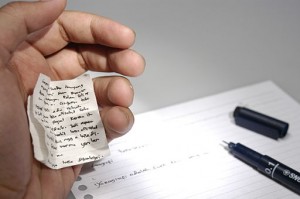By Laurie Meijer Drees, Teaching Faculty Member, First Nations Studies, Faculty of Arts and Humanities, VIU
As teachers, we should let our students cheat. We should encourage them to cheat. We should teach and model cheating. Good cheating.
Why? Because cheating is a way of finding answers using clever short-cuts, sharing information, learning about individual skills and talents and making use of them. It represents a chance to step out of conventional classroom ways of doing things. That, to me, is innovation. It is what university education can offer students.
In my experience, cheating can also build community. In our class we encourage students to “cheat” on their bibliographic references. These references must be perfect. Students quickly find out who in their class is good at referencing, who is good at copy-editing and who isn’t. They pride themselves in knowing their own talents and those of others. Soon, the whole class works together to get a perfect grade.
Teachers can also play a role. As instructors, we encourage students to “cheat” by asking us to check their answers before they hand them in. In no time they enjoy showing their homework and checking in. Students learn to ask for help and see the benefit immediately. Working together in this way a class grows stronger as everyone pitches in their talent to get maximum benefit for the whole group.
Playful cheating invites all to participate. Every year we laugh at our cheating. We laugh at ourselves and our limitations. We laugh knowing that someone out there will help us, and we can help them with something else. We love cheating.
Photo Attribution: By Hariadhi, myself (Own work) [GFDL (http://www.gnu.org/copyleft/fdl.html), CC-BY-SA-3.0 (http://creativecommons.org/licenses/by-sa/3.0/) or CC-BY-2.5 (http://creativecommons.org/licenses/by/2.5)], via Wikimedia Commons
